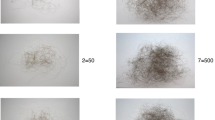Abstract
Odors produced in the human female axillae are of both biological and commercial importance. Several studies have suggested that extracts from female underarm secretions can alter the length and timing of the female menstrual cycle. In addition, more than 1.6 billion dollars are spent annually on products to eliminate or mask the axillary odors. Our recent studies have determined that the characteristic axillary odors in males consist of C6–C11, saturated, unsaturated and branched acids, with (E)-3-methyl-2-hexenoic acid (3M2H) being the major compound in this mixture. The 3M2H appears to be carried to the skin surface bound to two proteins in the axillary secretions. Data reported here show that the same mixture of odorous compounds is found in female axillary secretions, with several minor qualitative differences. Separation of the female apocrine secretions into aqueous and organic soluble fractions demonstrated that 3M2H, and several other members of the acids in the characteristic odor, are released by hydrolysis with base. Electrophoretic separation of the proteins found in the aqueous phase of female apocrine secretions revealed a pattern identical to that seen in males. The qualitative similarity of the acidic constituents making up the characteristic axillary odors of both females and males as well as the proteins present in the aqueous phase suggest a similar origin for axillary odors in both sexes.
Similar content being viewed by others
References
Budzikiewicz, H., Djerassi, C., andWilliams, D.H. 1967. Mass Spectometry of Organic Compounds, Holden-Day, Inc. San Francisco, pp. 155–162, 214–218.
Cutler, W.B., Preti, G., Krieger, A.M., Huggins, G.R., Garcia, C.R., andLawley, H.J. 1986. Human axillary secretions influence women's menstrual cycles: The role of donor extract from men.Horm. Behav. 20:463–473.
Doty, R.L. 1981. Olfactory communication in humans.Chem. Senses 6:351–376.
Gower, D.B., andRuparelia, B.A. 1993. Olfaction in humans with special reference to odorous 16-androstenes: Their occurrence, perception and possible social psychological and sexual impact.J. Endocrinol. 137:167–187.
Gower, A.B., Bird, S., Sharma, P., andHouse, F.D. 1985. Axillary 5α-androsten-16-en-3-one in men and women: Relationships with olfactory acuity to odorous 16-androstenes.Experientia 41:1134–1136.
Gower, D.B., Holland, K.T., Mallet, A.I., Rennie, P.J., andWatkins, W.J. 1994. Comparison of 16-androstene steroid concentrations in sterile apocrine sweat and axillary secretions: interconversions of 16-androstenes by the axillary microflora—a mechanism for axillary odour production in man?J. Ster. Biochem. Mol. Biol. 48:409–418.
Labows, J.N. 1988. Odor detection, generation and etiology in the axillae, pp. 321–343,in C. Felgen and K. Laden, (eds.). Antiperspirants and Deodorants. Marcel-Dekker, New York.
Labows, J.N., McGinley, K.J., Leyden, J.J., andWebster, G.F. 1979a. Characteristic γ-lactone odor production of the genuspityrosporum.Appl. Environ. Microbiol. 38(3):412–415.
Labows, J.N., Preti, G., Hoelzle, E., Leyden, J., andKligman, A. 1979b. Steroid analysis of human apocrine secretion.Steroids 34:249–258.
Labows, J.N., Preti, G., Hoelzle, E., Leyden, J.J., andKligman, A. 1979C. Analysis of human axillary volatiles: Compounds of exogenous origin.J. Chromatogr. 163:294–299.
Laemmli, U.K. 1970. Cleavage of structural proteins during the assembly of the head of a bacteriophage T4.Nature 227:680–685.
Leyden, J.J., McGinley, K.J., Hoelzle, K., Labows, J.N., andKligman, A.M. 1981. The microbiology of the human axillae and its relation to axillary odors.J. Invest. Dermatol. 77:413–416.
Leyden, J.J., Nordstrom, K.M. andMcGinley, K.J. 1991. Cutaneous microbiology, pp. 1403–1424,in L.A. Goldsmith, (ed.). Physiology, Biochemistry and Molecular Biology of the Skin. Oxford University Press, New York.
Preti, G., Cutler, W.B., Garcia, G.R., Huggins, G.R., andLawley, H.J. 1986. Human axillary secretions influence women's menstrual cycles: The role of donor extract of females.Horm. Behav. 20:474–482.
Preti, G., Cutler, W.B., Christensen, C.M., Lawley, H.J., Huggins, G.R. andGarcia, C.R. 1987. Human axillary extracts: Analysis of compounds from samples which influence menstrual timing.J. Chem. Ecol. 13:717–731.
Ramirez, A. 1990. The success of sweet smell. The New York Times. August 12, 1990.
Russell, M.J. 1976. Human olfactory communication.Nature 260:520–522.
Russell, M.J., Switz, G.M., andThompson, K. 1980. Olfactory influences on the human menstrual cycle.Pharmacol. Biochem. Behav. 13:737–738.
Spielman, A.I., Turner, G., Zeng, X.-N., Leyden, J.J., andPreti, G. 1994. Immunohistochemical localization of two protein precursors of the axillary odor.Chem. Senses 19:556–557 (abstract).
Spielman, A.I., Zeng, X-N., Leyden, J.J., andPreti, G. 1995. Proteinaceous precursors of human axillary odor: Isolation of two novel odor-binding proteins.Experientia 51:40–47.
Stern, K.N., andMcClintock, M.K. 1993. Pheromonal regulation of the human menstrual cycle. Conference on reproductive biology. East Lansing, Michigan, June 1993.
van den Dool, H., andKratz, H. 1963. A generalization of the retention index system including linear programmed gas liquid partition chromatography.J. Chromatogr. 11:463–471.
Zeng, X.-N., Leyden, J.J., Lawley, H.J., Sawano, K., Nohara, I., andPreti, G. 1991. Analysis of characteristic odors from human male axillae.J. Chem. Ecol. 17:1469–1492.
Zeng, X-N., Leyden, J.J., Brand, J.G., Spielman, A.I., McGinley, K., andPreti, G. 1992. An investigation of human apocrine gland secretion for axillary odor precursors.J. Chem. Ecol. 18:1039–1055.
Author information
Authors and Affiliations
Rights and permissions
About this article
Cite this article
Zeng, XN., Leyden, J.J., Spielman, A.I. et al. Analysis of characteristic human female axillary odors: Qualitative comparison to males. J Chem Ecol 22, 237–257 (1996). https://doi.org/10.1007/BF02055096
Received:
Accepted:
Issue Date:
DOI: https://doi.org/10.1007/BF02055096




